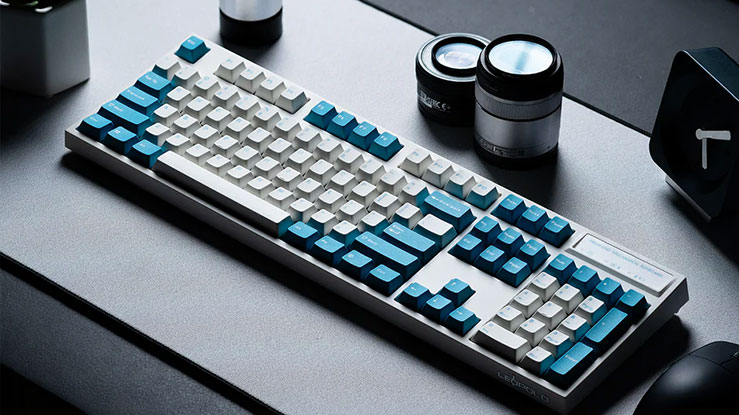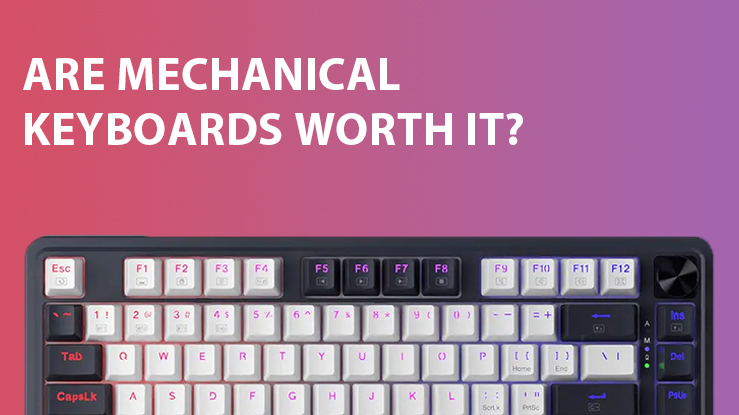ABS VS PBT, and Other Keycap Materials
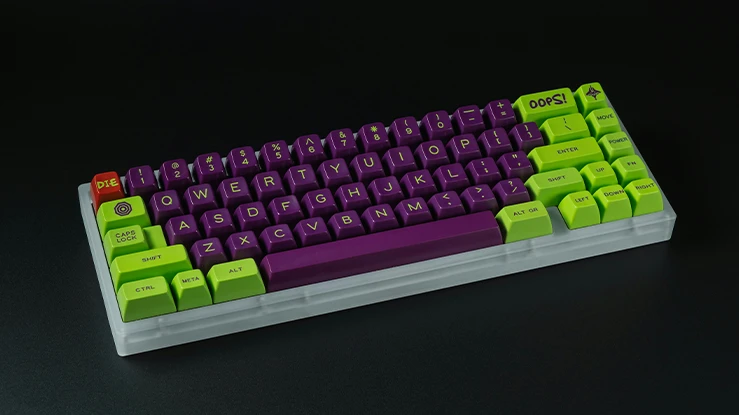
In this ultimate keycaps guide, we will cover everything you need to know about mechanical keyboard Keycaps, including keycap materials like PBT and ABS and keycap printing methods. This guide will also help you decide which keycaps to choose when buying a mechanical keyboard!
Keycap Materials
The table below gives a basic rundown of ABS and PBT Keycaps
| Keycap Materials | Texture | Price | Pros | Cons |
|---|---|---|---|---|
| ABS Keycaps | Smooth | $5 - $50 | More affordable, clack sound | wears out faster than PBT |
| PBT Keycaps | Textured Feel | $20 - $150 | Durable, thocky | could get expensive |
Nowadays, keycap materials come in two different types, PBT and ABS. Here is how these keycaps differ from each other.
ABS Keycaps
The first type of keycap is ABS (Acrylonitrile Butadiene Styrene). These keycaps are what we consider the baseline for mechanical keyboards, as they are the most commonly used. ABS keycaps are cheaper to produce, which makes them a good option for budget mechanical keyboards. They are widely available in prebuilt keyboards and budget keycap sets.
Some other pros of ABS keycaps include smooth texture and ease of molding compared to PBT, which we will discuss later. This allows manufacturers to give these keycaps intricate designs, and as they can easily be dyed, a wide variety of colors.
While they are cheaper to produce, there are some cons to them as well. ABS keycaps are less durable than PBT, as they develop a shine over time from constant use. Due to their soft nature, ABS keycaps are more prone to wear and key wobble over time.
However, there are some better-quality ABS keycaps as well. These keycaps are made from high-quality thick plastic to improve durability and offer a superior typing experience to regular ABS keycaps. One famous brand that makes these keycaps is GMK.
PBT Keycaps
The next widely popular keycaps are PBT (Polybutylene Terephthalate) keycaps. Unlike ABS Keycaps, which get a shine over time, PBT Keycaps are more durable and less resistant to that shine, which makes them a popular choice for those looking for high-quality mechanical keyboards.
PBT keycaps have a textured feel and are resistant to heat and chemicals. However, they also have some cons. Most PBT keycaps are used in high-end or high-budget mechanical keyboards. However, they are 100% worth it, in my opinion.
You should also know about some other premium PBT keycaps, such as ePBT or enjoyPBT. These PBT keycaps use thick, dye-sublimated legends that resist fading, often have a more solid feel, and produce a deeper sound when typing.
Another term I forgot to add is double-shot PBT keycaps. Although they are less common than double-shot ABS, some manufacturers produce double-shot PBT keycaps, which combine the durability of PBT with the long-lasting legends of the double-shot process.
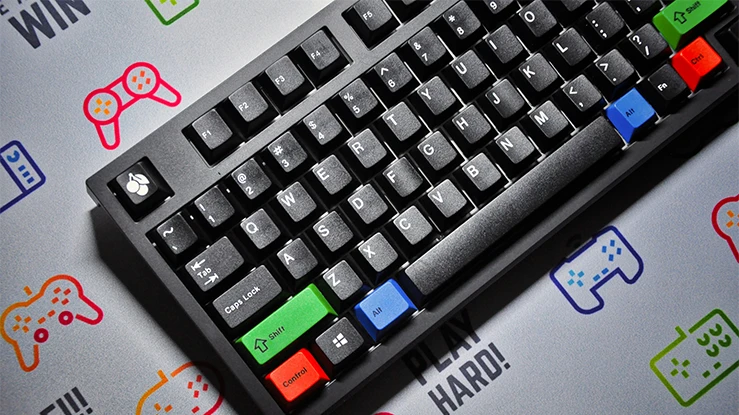
Other Keycap Materials – There are More?!
| Keycap Materials | Texture | Price | Pros | Cons |
|---|---|---|---|---|
| POM Keycaps | Buttery smooth texture, Self Lubricating | $30 - $100 | resists wear and shine | limited options |
| PC keycaps | Smooth, slightly grippy | $20 - $80 | Soft sound profile | scratches easily |
| Resin Keycaps | smooth, slightly glossy | $10 - $300 | Great for aesthetics, artisan builds | brittle and super expensive |
| Metal Keycaps | Cold and solid | $10 - $100+ | Super durable | can feel heavy |
In addition to ABS and PBT Keycaps, even more keycap materials are available. Like POM, PC, Resin, and Metal
POM Keycaps
POM (Polyoxymethylene) keycaps are known for their unique, buttery smooth texture and high resistance to wear. They are self-lubricating, which enhances the feel of keypresses over time.
POM keycaps are most common in enthusiast builds and high-end mechanical keyboards. The only drawback is that they are difficult to color match because they are self-lubricating. Since POM does not absorb dyes and pigments, achieving consistent color across keycaps is more difficult. Also, they are available in limited numbers.
PC (Polycarbonate) keycaps
Polycarbonate or PC keycaps are frequently used for pudding or translucent keycaps. These keycaps are essential for RGB fans as they help enhance their effects.
Some of their pros include being transparent, excellent for RGB lighting, and strong yet flexible, though this does not prevent them from being prone to scratches. These keycaps are a good choice if you are trying to build an aesthetic gaming setup. Or like trying to gain likes on Pinterest
Resin Keycaps – Keycap material for aesthetics
The next type of keycaps are resin keycaps. Resin keycaps are often handcrafted and come in various colors and intricate designs. They are mainly used for single artisan keycaps rather than complete sets. These keycaps give your keyboard an extra little style to them. You can have anime-styled keycaps or gaming-themed keycaps to give your mechanical keyboard that extra customization it needs.
Resin keycaps have their own set of pros and cons. Some pros include being highly customizable, meaning you can customize your keycaps to any design you want. Their only cons are that they are expensive and come in limited sets.
Metal Keycaps – Most Durable Keycap material
The final type of keycap material is metal keycaps. Due to their weight and material cost, metal keycaps are used mainly for single keys, such as escape keys, although some brands do offer a full metal keycap set. These keycaps are again common in high-value custom mechanical keyboards or enthusiast builds in general.
Metal keycaps are incredibly durable and give a mechanical keyboard a premium feel, but that comes at the expense of your wallet. A full metal keycap set could cost $100 or even more. This makes them a good choice for serious fans of the hobby, but for regular people like me, or assuming the reader as well, these are just not worth it.
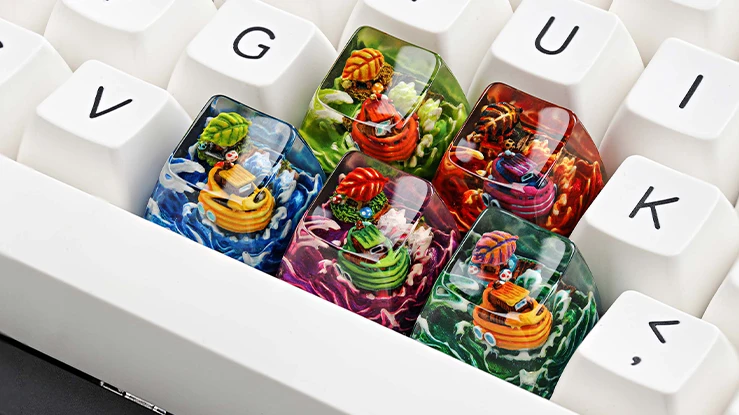
Keycaps Materials Printing methods
You must now be wondering, how the letters are even printed on these keycaps? Well, there are many ways in which legends or letters are printed. These include pad printing, laser etching, dye sublimation, and double-shot molding.
Pad Printing
Pad printing involves applying ink to the surface of the keycap, making it the least durable printing method. Although this type of printing is inexpensive and allows for vibrant colors, it wears off quickly with use and is just not durable. It is pretty common in budget keyboards and low-cost keycaps.
Laser Etching
Laser etching removes material from the keycap’s surface, slightly recessing legends or letters. It is often used for RGB shine-through keycaps. This type of printing is more durable than pad printing, but legends can still fade over time.
Dye Sublimation
Dye sublimation infuses ink into the plastic, making the legend part of the keycap itself. This method prevents legends from wearing off over time. As the ink is infused into the plastic, these high-quality keycaps are long-lasting and do not fade. However, this printing method is limited to PBT keycaps only.
Double-Shot Molding
Double-shot keycaps are made by molding two layers of plastic together, ensuring legends remain crisp and do not wear off. This method is considered to be the most durable, as letters never fade, but it is expensive to produce and has limited color options. This printing method is used to make premium keycap sets like GMK and high-end mechanical keyboards.
What to go for ABS or PBT? – Conclusion
Choosing the best keycaps depends on the reader. Choosing the best keycaps depends on the readers themselves. If you have a low budget, ABS might be a better choice, but if you need your mechanical keyboard to last long enough, PBT might be a better option. So it is best to know your budget, the time frame in which you want your keyboard to last, and finally, how you would go about customizing your mechanical keyboard.

